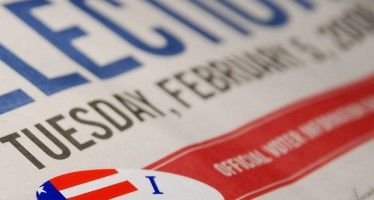Hard Hats And Enviros Hold Hands
OCT. 14, 2010
Don’t sweat it if you’ve never heard of the Blue-Green Alliance. I had never heard of it either, until a rally Thursday over at the Federal Building in downtown Sacramento for organized labor, Jerry Brown’s gubernatorial campaign and the proposed California High-Speed Rail project.
There I was, standing on the steps of the Federal Building behind four television cameras while a couple dozen hard hats stood off to the side holding banners for their respective unions and a succession of politicos and union bosses – including one who was wearing a hard hat emblazoned with two American flags – talked about how Meg Whitman was terrible for wanting to kill high-speed rail when suddenly this short guy in shorts and a boonie hat from the Sierra Club goes to the mike to sayhow great the bullet train will be for the environment.
Say what?
“We both support good green jobs,” Irvin Dawid said of a new bond between organized labor and environmentalists. “Brown stands for new clean renewable fuels.”
Dawid seemed, well, unsure of himself. He looked down at his notes a lot. The crowd of iron workers and construction guys listened quietly – too quietly, actually, since this was a political rally. But when Dawid wrapped up his remarks with a call for a “cleaner future, based on green jobs and Jerry Brown being our next governor,” the hard hats came through with their ovation.
Labor and environmentalists weren’t always this close. During the dark times of the Vietnam War, construction workers actually fought leftist radicals in the streets. In fact, right after the Kent State shootings in 1970, when the hard hats descended on war protesters in Manhattan, the blood really flowed.
“Suddenly, from all directions, two hundred construction workers marched in to the cadences of ‘All the way! USA!’ and ‘We’re number one!’ and ‘Love it or leave it!’” Rick Perlstein wrote in his 2008 book Nixonland. “In their identical brown overalls, carrying American flags of the sort that toped off construction sites, they looked like some sort of storm trooper battalion.”
Construction workers singled out those with long hair and attacked, sometimes pummeling the hippies with their own hard hats, lead pipes wrapped in American flags or sometimes just the flag. “I think this will help our boys over there by pulling this country together,” one construction worker told the Wall Street Journal. A week later, the Building Trades Council of Greater New York put a hundred thousand workers into New York City streets, many carrying signs that read “GOD BLESS THE ESTABLISHMENT.”
President Richard Nixon heartily approved. “Thank God for the hard hats!” he said.
But now, at least in California, the hard hats are standing with the hippie environmentalists. And forget Nixon – these guys want Jerry Brown.
Then again, that part isn’t so surprising. Back in 1992, Brown was the only Democratic presidential candidate who consistently wore a union jacket and pushed labor’s line on the issues.
But high-speed rail?
“We have come together because the building of a high-speed rail system in California will create sustainable green jobs, spur economic growth and protect our environment,” Art Pulaski of the California Labor Federation, Allan Zaremberg of the CalChamber and Sierra Club California’s Jim Metropulos recently told U.S. Transportation Secretary Ray LaHood.
Of course, how much economic growth and how many “green jobs” isn’t really known (during the rally, organizers said the rail project would create 140,000 construction jobs, while the letter to Ray LaHood cited above mentioned 130,000 jobs). But Sierra Club’s interest in the project is real.
Well, mostly.
“On high-speed rail, we are in total support,” Dawid told me after the rally. “Now, environmentalists are not 100 percent unified, but Sierra Club California is.”
Dawid knows this first-hand. During the rally, Pulaski said something that wasn’t even close to true. “Just about everyone in California supports it (high-speed rail),” Pulaski said. “One of the few who doesn’t is Meg Whitman.”
That line got some good booing from the crowd. But then Pulaski overstepped when he mentioned that Whitman lives in Atherton. “Atherton is the only place in California trying to oppose high-speed rail,” he said, adding that opponents are just a bunch of rich people who “live in multi-million-dollar homes” who think the bullet trains “will disturb their sleep.”
Actually, residents and officials in a number of cities across the state – like, for instance, the working class city of Orange in Southern California – have deep reservations about the bullet trains, which will cost somewhere between $40 billion and $90 billion. Every part of the state is different, and local environmental groups across the state have different ideas about how the train should look.
“Some of the chapters will become more involved in terms of making it better, not in terms of killing it, which is what my city is doing,” Dawid said.
Dawid is from Palo Alto, which is actually suing the High-Speed Rail Authority. And Dawid knows that Pulaski’s demonization of rail opponents isn’t realistic. “I think there are just many people afraid of losing their homes or seeing their property values going down,” he told me.
-Anthony Pignataro
Related Articles
Ignorance abounds in gun control stories
August 7, 2012 By Katy Grimes Within minutes of the most recent Colorado and Wisconsin massacres, breathless reporters and opportunistic
Popular vote by 2020?
Though it means nothing for 2016, the 2020 presidential election may be decided by popular vote — or at least that’s
Are skewed polls over-sampling Dems?
Sept. 24, 2012 By Katy Grimes During Presidential elections, many political pundits say that voters should not pay attention to



